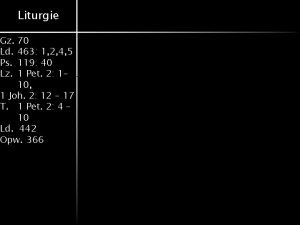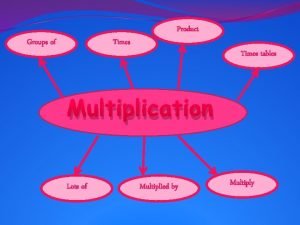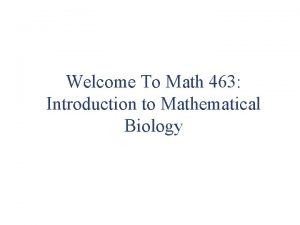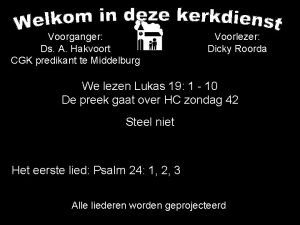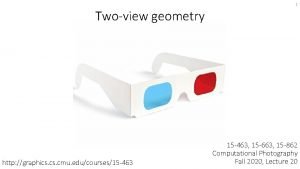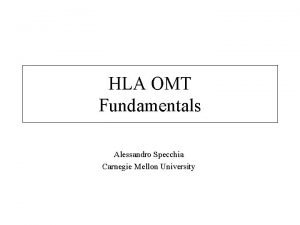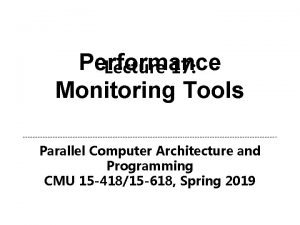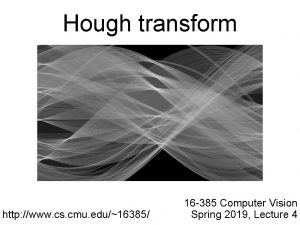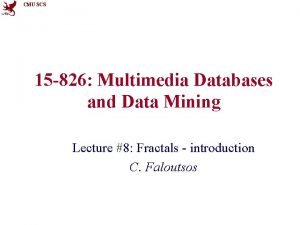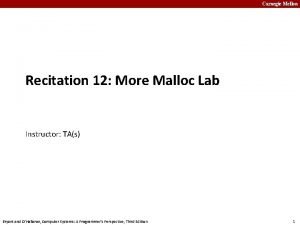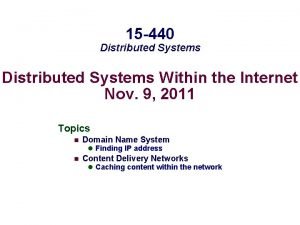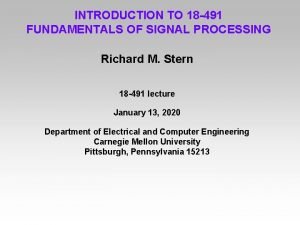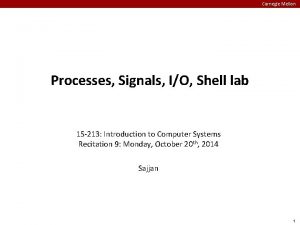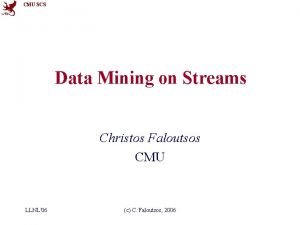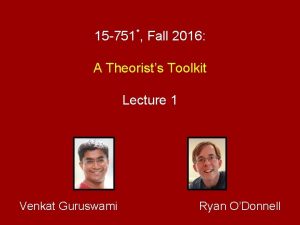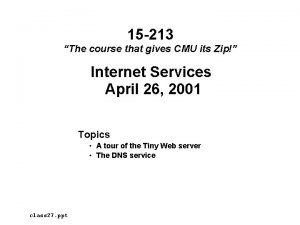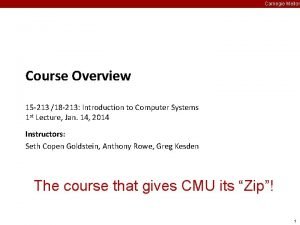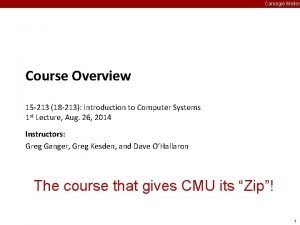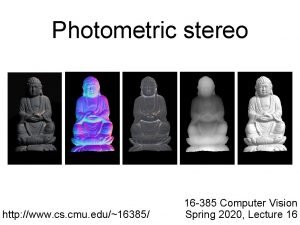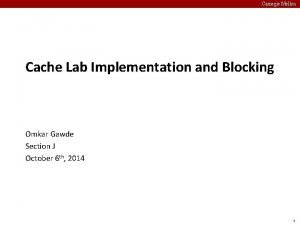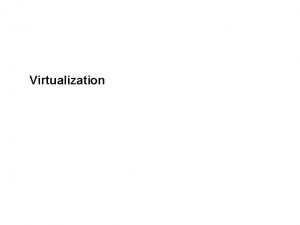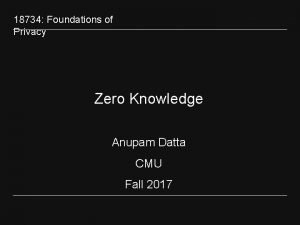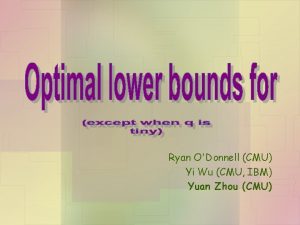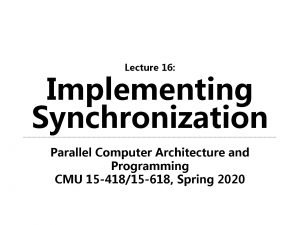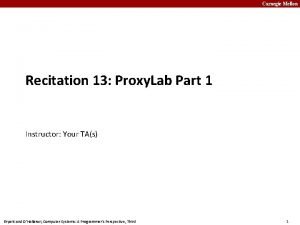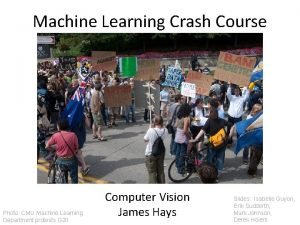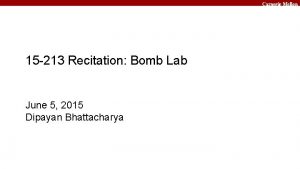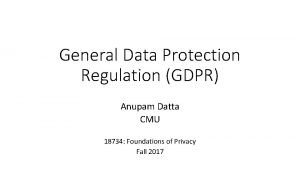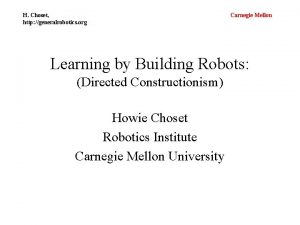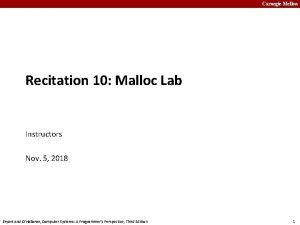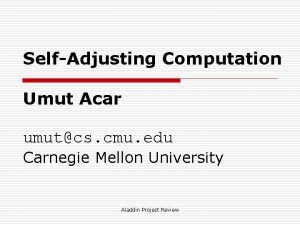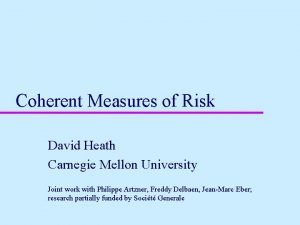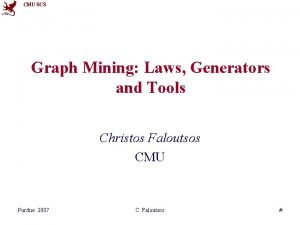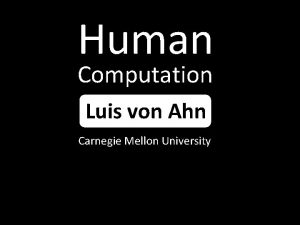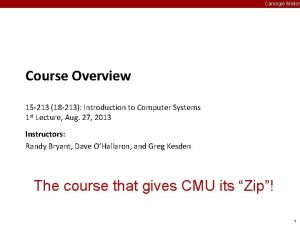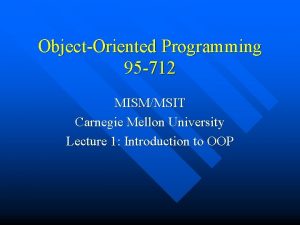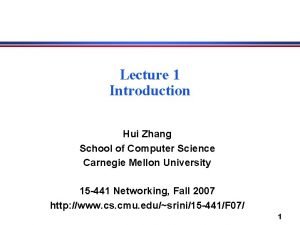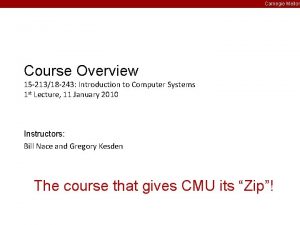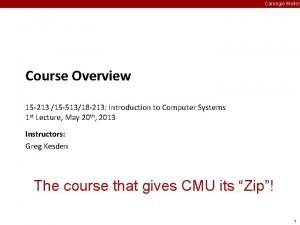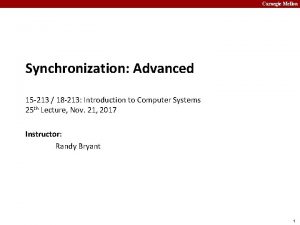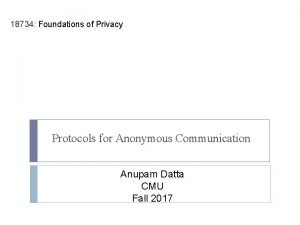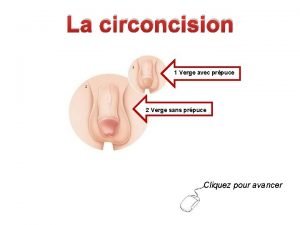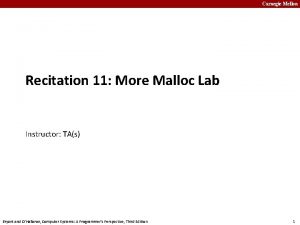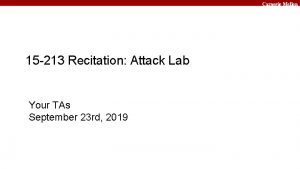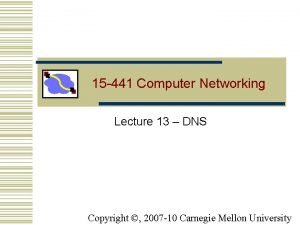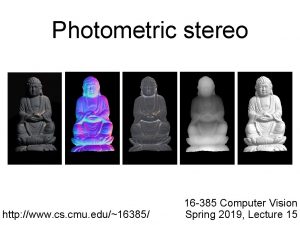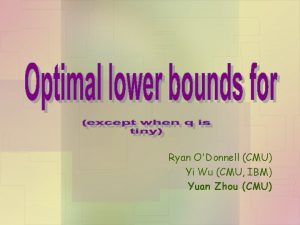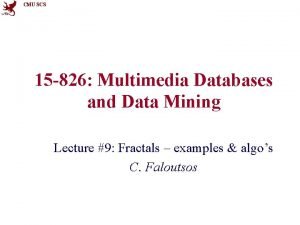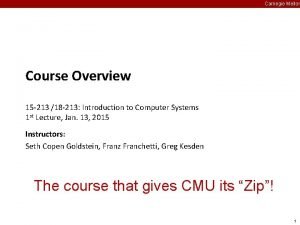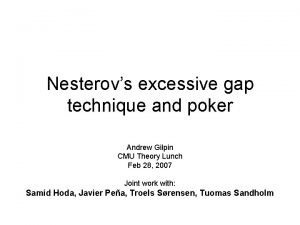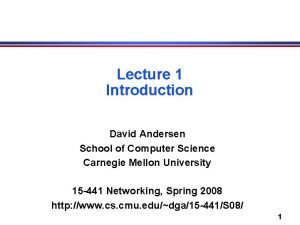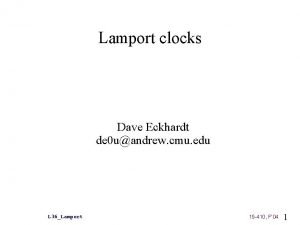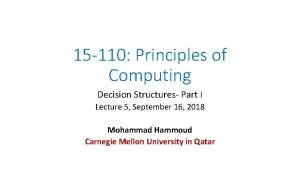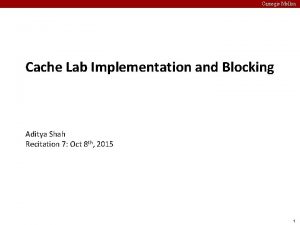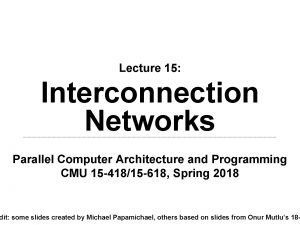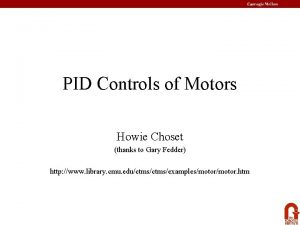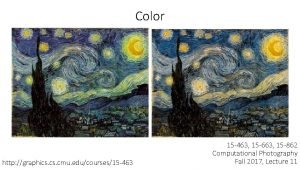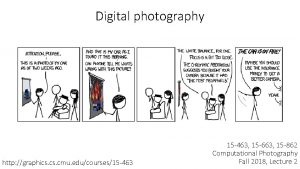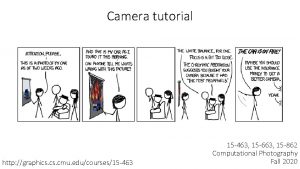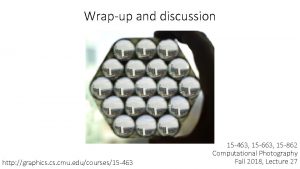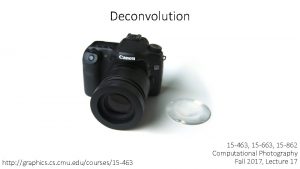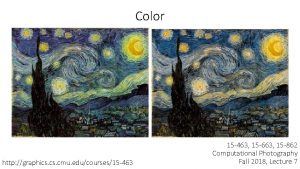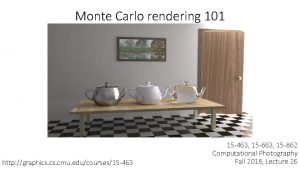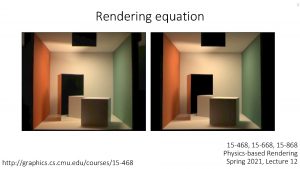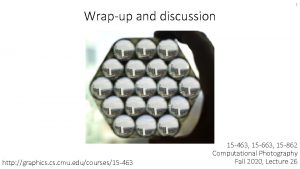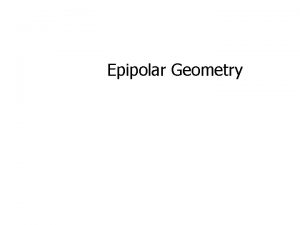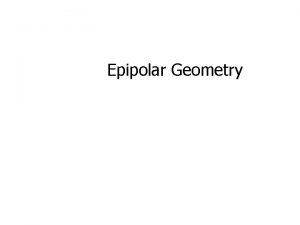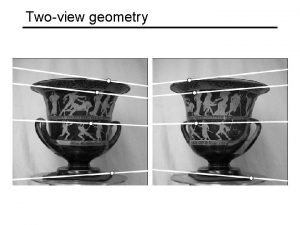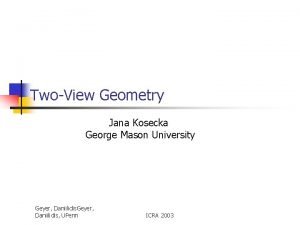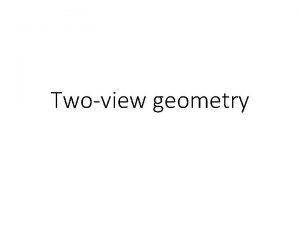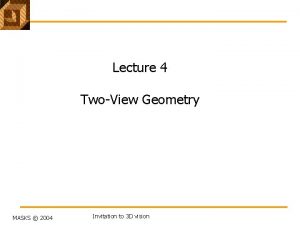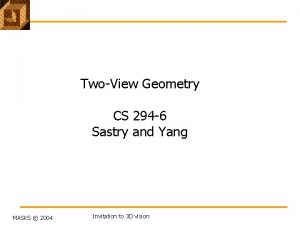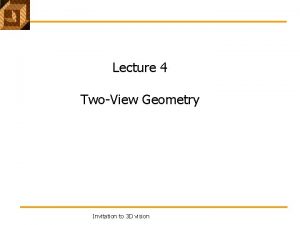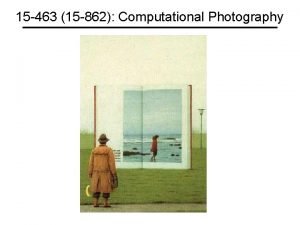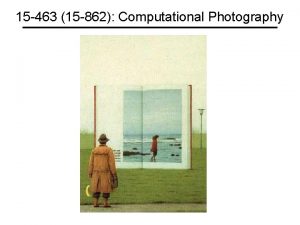1 Twoview geometry http graphics cmu educourses15 463












































































![77 putting it together rigid motion coplanarity Essential Matrix [Longuet-Higgins 1981] 77 putting it together rigid motion coplanarity Essential Matrix [Longuet-Higgins 1981]](https://slidetodoc.com/presentation_image_h/2657a89cc0a372321e2e94d383026d6b/image-77.jpg)






































- Slides: 115

1 Two-view geometry http: //graphics. cmu. edu/courses/15 -463, 15 -663, 15 -862 Computational Photography Fall 2020, Lecture 20

2 Course announcements • Homework assignment 5 is due today. - Any questions? • Homework assignment 6 will be posted tonight. - Start early: Capturing structured light stereo is challenging. • Grades for homework assignment 4 posted. • New policy: Please post regrade requests on gradescope. • You can suggest topics for next reading group (Friday 3: 30 -5: 30 pm) on Piazza.

3 Overview of today’s lecture • Leftover from cameras. • Triangulation. • Epipolar geometry. • Essential matrix. • Fundamental matrix. • 8 -point algorithm.

4 Overview of today’s lecture • Leftover from cameras. • Triangulation. • Epipolar geometry. • Essential matrix. • Fundamental matrix. • 8 -point algorithm.

5 Slide credits Many of these slides were adapted from: • Kris Kitani (16 -385, Spring 2017). • Srinivasa Narasimhan (16 -720, Fall 2017).

6 Triangulation

7 Triangulation image 1 image 2 Given camera 1 with matrix camera 2 with matrix

8 Triangulation Which 3 D points map to x? image 1 camera 1 with matrix image 2 camera 2 with matrix

9 Triangulation How can you compute this ray? image 1 camera 1 with matrix image 2 camera 2 with matrix

10 Triangulation Create two points on the ray: 1) find the camera center; and 2) apply the pseudo-inverse of P on x. Then connect the two points. This procedure is called backprojection + Why does this point map to x? image 1 camera 1 with matrix image 2 camera 2 with matrix

11 Triangulation How do we find the exact point on the ray? image 1 camera 1 with matrix + image 2 camera 2 with matrix

12 Triangulation Find 3 D object point Will the lines intersect? image 1 camera 1 with matrix image 2 camera 2 with matrix

13 Triangulation Find 3 D object point (no single solution due to noise) image 1 camera 1 with matrix image 2 camera 2 with matrix

14 Triangulation Given a set of (noisy) matched points and camera matrices Estimate the 3 D point

15 known Can we compute X from a single correspondence x?

16 (homogeneous coordinate) This is a similarity relation because it involves homogeneous coordinates (homorogeneous coordinate) Same ray direction but differs by a scale factor How do we solve for unknowns in a similarity relation?

17 (homogeneous coordinate) Also, this is a similarity relation because it involves homogeneous coordinates (inhomogeneous coordinate) Same ray direction but differs by a scale factor How do we solve for unknowns in a similarity relation?

18 Linear algebra reminder: cross product Vector (cross) product takes two vectors and returns a vector perpendicular to both cross product of two vectors in the same direction is zero vector remember this!!!

19 Linear algebra reminder: cross product Can also be written as a matrix multiplication Skew symmetric

20 Compare with: dot product of two orthogonal vectors is (scalar) zero

21 Back to triangulation Same direction but differs by a scale factor How can we rewrite this using vector products?

22 Same direction but differs by a scale factor Cross product of two vectors of same direction is zero (this equality removes the scale factor)

23 Do the same after first expanding out the camera matrix and points

24 Using the fact that the cross product should be zero Third line is a linear combination of the first and second lines. (x times the first line plus y times the second line) One 2 D to 3 D point correspondence give you 2 equations

25 Using the fact that the cross product should be zero Third line is a linear combination of the first and second lines. (x times the first line plus y times the second line) One 2 D to 3 D point correspondence give you 2 equations

26 Remove third row, and rearrange as system on unknowns Now we can make a system of linear equations (two lines for each 2 D point correspondence)

27 Concatenate the 2 D points from both images Two rows from camera one Two rows from camera two sanity check! dimensions? How do we solve homogeneous linear system?

28 Concatenate the 2 D points from both images How do we solve homogeneous linear system? S V D !

29 Epipolar geometry

30 Epipolar geometry Image plane

31 Epipolar geometry Baseline Image plane

32 Epipolar geometry Baseline Image plane Epipole (projection of o’ on the image plane)

33 Epipolar geometry Epipolar plane Baseline Image plane Epipole (projection of o’ on the image plane)

34 Epipolar geometry Epipolar line (intersection of Epipolar plane and image plane) Epipolar plane Baseline Image plane Epipole (projection of o’ on the image plane)

35 Quiz What is this?

36 Quiz Epipolar plane

37 Quiz What is this? Epipolar plane

38 Quiz Epipolar line (intersection of Epipolar plane and image plane) Epipolar plane

39 Quiz Epipolar line (intersection of Epipolar plane and image plane) Epipolar plane What is this?

40 Quiz Epipolar line (intersection of Epipolar plane and image plane) Epipolar plane Epipole (projection of o’ on the image plane)

41 Quiz Epipolar line (intersection of Epipolar plane and image plane) Epipolar plane What is this? Epipole (projection of o’ on the image plane)

42 Quiz Epipolar line (intersection of Epipolar plane and image plane) Epipolar plane Baseline Epipole (projection of o’ on the image plane)

43 Backproject to a ray in 3 D Epipolar constraint Epipolar line (intersection of Epipolar plane and image plane) Another way to construct the epipolar plane, this time given

44 Epipolar constraint Potential matches for lie on the epipolar line

45 The point x (left image) maps to a ______ in the right image The baseline connects the ______ and ______ An epipolar line (left image) maps to a _____ in the right image An epipole e is a projection of the _______ on the image plane All epipolar lines in an image intersect at the _______

46 Converging cameras Where is the epipole in this image?

47 Converging cameras here! Where is the epipole in this image? It’s not always in the image

48 Parallel cameras Where is the epipole?

49 Parallel cameras epipole at infinity

50 The epipolar constraint is an important concept for stereo vision Task: Match point in left image to point in right image Left image Right image How would you do it?

51 Epipolar constraint Potential matches for lie on the epipolar line

52 The epipolar constraint is an important concept for stereo vision Task: Match point in left image to point in right image Left image Right image Want to avoid search over entire image Epipolar constraint reduces search to a single line

53 The epipolar constraint is an important concept for stereo vision Task: Match point in left image to point in right image Left image Right image Want to avoid search over entire image Epipolar constraint reduces search to a single line How do you compute the epipolar line?

54 The essential matrix

55 Recall: Epipolar constraint Potential matches for lie on the epipolar line

56 Given a point in one image, multiplying by the essential matrix will tell us the epipolar line in the second view.

57 Motivation The Essential Matrix is a 3 x 3 matrix that encodes epipolar geometry Given a point in one image, multiplying by the essential matrix will tell us the epipolar line in the second image.

58 Representing the … Epipolar Line in vector form If the point is on the epipolar line then

59 Epipolar Line in vector form If the point is on the epipolar line then

60 So if and then

61 So if and then

62 Essential Matrix vs Homography What’s the difference between the essential matrix and a homography?

63 Essential Matrix vs Homography What’s the difference between the essential matrix and a homography? They are both 3 x 3 matrices but … Essential matrix maps a point to a line Homography maps a point to a point

64 Where does the essential matrix come from?

65

66 Does this look familiar?

67 Camera-camera transform just like world-camera transform

68 These three vectors are coplanar

69 If these three vectors are coplanar then

70 If these three vectors are coplanar then dot product of orthogonal vectors cross-product: vector orthogonal to

71 If these three vectors are coplanar then

72 If these three vectors are coplanar then

73 putting it together rigid motion coplanarity

74 putting it together rigid motion use skew-symmetric matrix to represent cross product coplanarity

75 putting it together rigid motion coplanarity

76 putting it together rigid motion coplanarity
![77 putting it together rigid motion coplanarity Essential Matrix LonguetHiggins 1981 77 putting it together rigid motion coplanarity Essential Matrix [Longuet-Higgins 1981]](https://slidetodoc.com/presentation_image_h/2657a89cc0a372321e2e94d383026d6b/image-77.jpg)
77 putting it together rigid motion coplanarity Essential Matrix [Longuet-Higgins 1981]

78 properties of the E matrix Longuet-Higgins equation (2 D points expressed in camera coordinate system)

79 properties of the E matrix Longuet-Higgins equation Epipolar lines (2 D points expressed in camera coordinate system)

80 properties of the E matrix Longuet-Higgins equation Epipolar lines Epipoles (2 D points expressed in camera coordinate system)

81 Given a point in one image, multiplying by the essential matrix will tell us the epipolar line in the second view. Assumption: 2 D points expressed in camera coordinate system (i. e. , intrinsic matrices are identities)

82 How do you generalize to nonidentity intrinsic matrices?

83 The fundamental matrix

84 The fundamental matrix is a generalization of the essential matrix, where the assumption of Identity matrices is removed

85 The essential matrix operates on image points expressed in 2 D coordinates expressed in the camera coordinate system camera point image point

86 The essential matrix operates on image points expressed in 2 D coordinates expressed in the camera coordinate system camera point image point Writing out the epipolar constraint in terms of image coordinates

87 Same equation works in image coordinates! it maps pixels to epipolar lines

88 F properties of the E matrix Longuet-Higgins equation Epipolar lines Epipoles F F F (points in image coordinates)

89 Breaking down the fundamental matrix Depends on both intrinsic and extrinsic parameters

90 Breaking down the fundamental matrix Depends on both intrinsic and extrinsic parameters How would you solve for F?

91 The 8 -point algorithm

92 Assume you have M matched image points Each correspondence should satisfy How would you solve for the 3 x 3 F matrix?

93 Assume you have M matched image points Each correspondence should satisfy How would you solve for the 3 x 3 F matrix? S V D

94 Assume you have M matched image points Each correspondence should satisfy How would you solve for the 3 x 3 F matrix? Set up a homogeneous linear system with 9 unknowns

95 How many equation do you get from one correspondence?

96 ONE correspondence gives you ONE equation

97 Set up a homogeneous linear system with 9 unknowns How many equations do you need?

98 Each point pair (according to epipolar constraint) contributes only one scalar equation Note: This is different from the Homography estimation where each point pair contributes 2 equations. We need at least 8 points Hence, the 8 point algorithm!

99 How do you solve a homogeneous linear system?

100 How do you solve a homogeneous linear system? Total Least Squares minimize subject to

101 How do you solve a homogeneous linear system? Total Least Squares minimize subject to S V D !

102 Eight-Point Algorithm 0. (Normalize points) 1. Construct the M x 9 matrix A 2. Find the SVD of A 3. Entries of F are the elements of column of V corresponding to the least singular value 4. (Enforce rank 2 constraint on F) 5. (Un-normalize F)

103 Eight-Point Algorithm 0. (Normalize points) 1. Construct the M x 9 matrix A 2. Find the SVD of A 3. Entries of F are the elements of column of V corresponding to the least singular value 4. (Enforce rank 2 constraint on F) 5. (Un-normalize F) See Hartley. Zisserman for why we do this

104 Eight-Point Algorithm 0. (Normalize points) 1. Construct the M x 9 matrix A 2. Find the SVD of A 3. Entries of F are the elements of column of V corresponding to the least singular value 4. (Enforce rank 2 constraint on F) 5. (Un-normalize F) How do we do this?

105 Eight-Point Algorithm 0. (Normalize points) 1. Construct the M x 9 matrix A 2. Find the SVD of A 3. Entries of F are the elements of column of V corresponding to the least singular value 4. (Enforce rank 2 constraint on F) 5. (Un-normalize F) How do we do this? S V D !

106 Enforcing rank constraints Problem: Given a matrix F, find the matrix F’ of rank k that is closest to F, Solution: Compute the singular value decomposition of F, Form a matrix Σ’ by replacing all but the k largest singular values in Σ with 0. Then the problem solution is the matrix F’ formed as,

107 Eight-Point Algorithm 0. (Normalize points) 1. Construct the M x 9 matrix A 2. Find the SVD of A 3. Entries of F are the elements of column of V corresponding to the least singular value 4. (Enforce rank 2 constraint on F) 5. (Un-normalize F)

108 Example

109 epipolar lines

110

111

112 Where is the epipole? How would you compute it?

113 The epipole is in the right null space of F How would you solve for the epipole?

114 The epipole is in the right null space of F How would you solve for the epipole? S V D !

115 References Basic reading: • Szeliski textbook, Section 8. 1 (not 8. 1. 1 -8. 1. 3), Chapter 11, Section 12. 2. • Hartley and Zisserman, Section 11. 12.
 Gaming employee registration
Gaming employee registration Lied 463
Lied 463 Multiplicand and multiplier
Multiplicand and multiplier Math 463
Math 463 Cgk middelburg
Cgk middelburg Computer graphics cmu
Computer graphics cmu Graphics monitors in computer graphics
Graphics monitors in computer graphics 3d viewing devices in computer graphics ppt
3d viewing devices in computer graphics ppt Geometry in computer graphics
Geometry in computer graphics Lewis structures and molecular geometry
Lewis structures and molecular geometry 4 electron domains 2 lone pairs
4 electron domains 2 lone pairs Bonding theories
Bonding theories Http //mbs.meb.gov.tr/ http //www.alantercihleri.com
Http //mbs.meb.gov.tr/ http //www.alantercihleri.com Siat.ung.ac.id
Siat.ung.ac.id Canvas.cmu edu
Canvas.cmu edu Cmu machine learning
Cmu machine learning Vyas sekar
Vyas sekar Cmu fom
Cmu fom Cmu 18-447
Cmu 18-447 Cmu speech recognition
Cmu speech recognition Cmu 15-418
Cmu 15-418 Cmu 16720
Cmu 16720 Cmu library
Cmu library Cmu
Cmu Garbled bytes
Garbled bytes 15-213
15-213 15-440 cmu
15-440 cmu Richard stern cmu
Richard stern cmu Cmu shell lab
Cmu shell lab Cmu immunization
Cmu immunization Tom cortina cmu
Tom cortina cmu Eric xing cmu
Eric xing cmu Data mining cmu
Data mining cmu Cs theory toolkit
Cs theory toolkit Cmu machine learning
Cmu machine learning 14848 cmu
14848 cmu Cmu 15-213
Cmu 15-213 Cmu autolab
Cmu autolab Carnegie mellon vpn
Carnegie mellon vpn Gregory kesden cmu
Gregory kesden cmu 18-213 cmu
18-213 cmu 16385 cmu
16385 cmu Canvas cmu
Canvas cmu Cache lab cmu
Cache lab cmu Vmware cmu
Vmware cmu 18734 cmu
18734 cmu Ryan o'donnell cmu
Ryan o'donnell cmu Parallel computer architecture cmu
Parallel computer architecture cmu Proxy lab
Proxy lab Cmu machine learning course
Cmu machine learning course Cmu sio
Cmu sio Bibliothèque cmu
Bibliothèque cmu Cmu bomb threat
Cmu bomb threat Anupam datta cmu
Anupam datta cmu Cmu robotics minor
Cmu robotics minor Hui zhang cmu
Hui zhang cmu Sandboxing urban dictionary
Sandboxing urban dictionary Cmu rapid prototyping
Cmu rapid prototyping Lorrie faith cranor
Lorrie faith cranor Malloc lab checkpoint
Malloc lab checkpoint Umut acar
Umut acar David eber cmu
David eber cmu Healthconnect cmu
Healthconnect cmu Cmu mld
Cmu mld Cmu distributed systems
Cmu distributed systems Luis von ahn human computation
Luis von ahn human computation Cmu 15-213
Cmu 15-213 Cmu mism
Cmu mism Cmu it
Cmu it Tetrad cmu
Tetrad cmu Canvas cmu
Canvas cmu Machine learning slides
Machine learning slides Hui zhang cmu
Hui zhang cmu Chris atkeson cmu
Chris atkeson cmu Assembly bomb lab
Assembly bomb lab Bill nace cmu
Bill nace cmu Hci major
Hci major Cmu 15-513
Cmu 15-513 Vanessa branch cmu
Vanessa branch cmu Phil gibbons cmu
Phil gibbons cmu 18-213 cmu
18-213 cmu 18734 cmu
18734 cmu Cmu library
Cmu library Verge
Verge Cmu malloc lab
Cmu malloc lab Attack lab
Attack lab Hoda heidari cmu
Hoda heidari cmu Cmu snake robot
Cmu snake robot 15213 bomb lab
15213 bomb lab 10417 cmu
10417 cmu Cmu data mining
Cmu data mining Cmu 15-441
Cmu 15-441 Aditi sharma cmu
Aditi sharma cmu Cmu 16385
Cmu 16385 Machine learning definition tom mitchell
Machine learning definition tom mitchell Cmu proxy
Cmu proxy Ryan o'donnell cmu
Ryan o'donnell cmu Cmu
Cmu Cmu panoptic dataset
Cmu panoptic dataset Cmu bioinformatics
Cmu bioinformatics Lee weiss cmu
Lee weiss cmu Cmu 15-213
Cmu 15-213 Citi training cmu
Citi training cmu Cmu computational biology
Cmu computational biology Poker gap
Poker gap Kevin lin cmu
Kevin lin cmu Canvas cmu
Canvas cmu David andersen cmu
David andersen cmu 15-410 cmu
15-410 cmu Space line
Space line Brian railing cmu
Brian railing cmu Cmu 15-110
Cmu 15-110 Igemdock
Igemdock Cache efficient matrix transpose
Cache efficient matrix transpose Cmu parallel computing
Cmu parallel computing Cmu library
Cmu library

